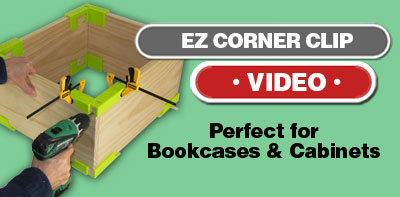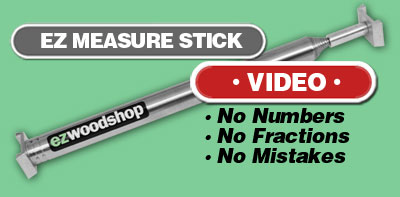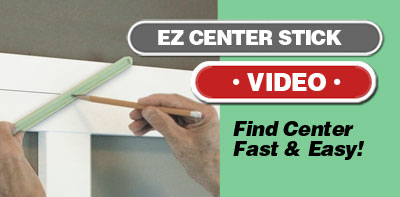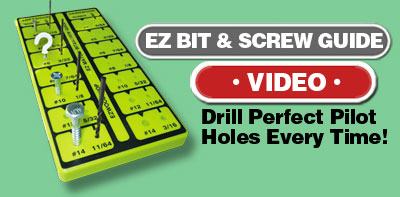Plywood Grades - A, B, C, D
What Do the Letters Mean?
Softwood Plywood Grades
The grading system for softwood plywood is one of the easier puzzles to solve when it comes to buying lumber and wood project materials - thanks to the simple A-D letter system used to indicate the quality of the panel. The primary difference between one grade and another is the number of knot holes and voids you'll find in the layers of veneer - defects which occur naturally in just about all type of softwood plywood. The number of defects in a panel - and the amount of work a wood mill has done to repair the defects - will determine the grade and the price of plywood.
Plywood Grades A & B
The highest quality - and most expensive - types of softwood plywood are the A & B grades - which is perfect for shop projects like workbench plans. All large knots are replaced with football-shaped patches, which can be sanded and finished with the rest of the panel. Also, any gaps or voids along the edges of the panel are usually filled and smoothed off with wood putty. With the A & B grades, the number of repaired patches and voids on any given sheet will be low. Not all home centers carry the higher-quality A & B grades of plywood. Try contacting your closest lumber distributor of woodworking supply store for more information and availability.
Plywood Grades C & D
The more economical types of plywood are the C & D grades. You'll see more repaired knots and voids on a sheet, and some defects will be left as is. This type of plywood grade is a good choice for projects where you will ultimately cover the plywood panel with some other type of cover material - like a smoother MDF sheet.
Construction Plywood vs Project Plywood
First understand that home improvement centers cater not only to homeowners, but also to general contractors. That means most plywood at the “big box” stores is for roofing houses, building garages, and covering bathroom floors (it’s called sheathing). You’ll have to look a little deeper in the aisles to find plywood better suited for projects like cabinets. This doesn’t mean you can’t use plywood sheathing for small projects. In fact, sheathing might be your best choice for things like shelving in the garage, storage cabinets in the basement—or anything where function is more important than appearance. Sheathing might be a little rough to the touch, but it’s still an amazingly strong and durable piece of material. Best part is the price – which is well below the cost of other types of plywood.
CDX - Another type of construction sheathing that might work okay for rough shop projects, like work tables and storage. It’s moisture resistant.
Sanded Pine - With its clean, smooth surface (one or both sides), sanded pine is perfect for building project boxes and cabinets.
Baltic Birch - Here’s the ultimate plywood for building nice shop furniture. No need to hide the edges, they’re clean and attractive.
Indoor vs Outdoor
The big question to ask before buying plywood is where you plan to locate the finished project—in the house or in the backyard. Plywood manufacturers are very specific about this difference, and are careful to label their products for indoor or outdoor use.
Plywood for Indoor Projects
For projects that never see the light of day (like cabinets and shop furniture) there’s a wide range of plywoods to choose from. Whether your local home center has all of them in stock is another matter, but most stores should have at least a few of the varieties listed below. Pine Veneer My favorite type of plywood for building indoor projects is made from pine veneers, and is usually labeled something like “Sanded Pine BC” or “ Sandeply.” These panels work great for simple wood projects. They’re relatively inexpensive ($20 or less), and have one side that’s sanded smooth for painting or finishing. Oriented Strand Board (OSB) Sometimes called “wafer board,” OSB is made from wood chips glued together in an odd, patchwork design. The crude surface might be too rough for building boxes and cabinets, but that’s a judgement call you’ll have to make for yourself. Check out the OSB panels at your local home center see what you think.
Plywood for Outdoor Projects - Pressure Treated
Weather is hard on any kind of wood, but it’s especially hard on the delicate wood veneers in a sheet of plywood. Rain, sleet, snow, and even the sun itself can literally destroy plywood in just a few months. And that’s not including all the damage from insects. The only practical solution for using plywood outdoors is to buy plywood that’s made especially for the outdoors. However, be careful not to confuse the words “outdoor,” “exterior,” and “pressure treated” to all mean the same thing. In many cases, they’re not. Some types of outdoor plywood can withstand years of direct exposure to rain and snow, some can’t.
Pressure-treated plywood, which is saturated with chemicals to ward off mold, mildew, and insects, can survive outside for decades without paint or a protective finish. In most home centers, pressure-treated lumber is located in its own aisle, and has a distinctive green cast to its color.
CDX sheathing is used primarily by contractors to build exterior walls and roofs. The letters “CD” represent the veneer grades used on the front and back, and “X” means the glue (not the wood) is rated for outdoor exposure—but only for a short time. Eventually the panel must be covered by something more weather resistant—like bricks, siding or shingles. CDX can be an inexpensive alternative to some of the more expensive pine plywoods, although it’s considerably more rough on both the surface and the edges. For down-and-dirty projects, like garage shelves and storage bins, CDX can be the perfect budget-minded choice for wood projects.
Hardware for Pressure-Treated Plywood
Keep in mind that pressure-treated plywood has a tendency to corrode and destroy metal—up to five times faster than untreated wood. That means you’ll need to use hardware and fasteners designed especially for pressure-treated wood. Look for fasteners labeled “exterior” or “galvanized” or “stainless steel.”
.
Safety Issues When Working with Plywood
.
Plywood Dust - Inhaling dust from any type of wood can be unhealthy, but dust from treated lumber is especially toxic. Keep in mind that whatever chemicals were used to treat the lumber will also be in the dust released. Always wear a good dust mask and safety glasses when cutting treated lumber. And if possible, cut your treated lumber outside and away from your house.
Plywood Glues - Some consumer advocate groups are concerned about the possible health hazards of adhesive chemicals used in plywood—especially urea formaldehyde and phenol formaldehyde. As a result, some plywood manufacturers now use low formaldehyde-emitting glue systems, denoted by an “E” rating. Check with your local plywood supplier and ask about E-rated plywood.



